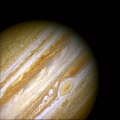ملف:An Ancient Storm in the Jovian Atmosphere - GPN-2000-000910.jpg

حجم هذه المعاينة: 601 × 599 بكسل. الأبعاد الأخرى: 241 × 240 بكسل | 481 × 480 بكسل | 770 × 768 بكسل | 1٬027 × 1٬024 بكسل | 1٬496 × 1٬492 بكسل.
الملف الأصلي (1٬496 × 1٬492 بكسل حجم الملف: 701 كيلوبايت، نوع MIME: image/jpeg)
تاريخ الملف
اضغط على زمن/تاريخ لرؤية الملف كما بدا في هذا الزمن.
| زمن/تاريخ | صورة مصغرة | الأبعاد | مستخدم | تعليق | |
|---|---|---|---|---|---|
| حالي | 21:20، 17 يناير 2016 |  | 1٬496 × 1٬492 (701 كيلوبايت) | Ras67 | higher resolution |
| 00:50، 9 أبريل 2009 |  | 718 × 716 (261 كيلوبايت) | BotMultichillT | {{Information |Description={{en|1=When 17th-century astronomers first turned their telescopes to Jupiter, they noted a conspicuous reddish spot on the giant planet. This Great Red Spot is still present in Jupiter's atmosphere, more than 300 years later. I |
استخدام الملف
الصفحتان التاليتان تستخدمان هذا الملف:
الاستخدام العالمي للملف
الويكيات الأخرى التالية تستخدم هذا الملف:
- الاستخدام في ru.wikipedia.org
- الاستخدام في sk.wikipedia.org

